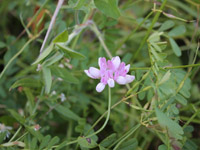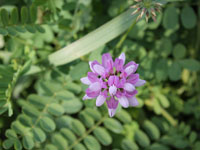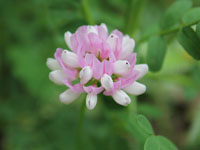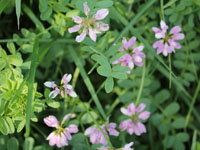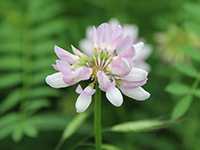![]()
Crown Vetch or purple crown vetch, is a low-growing legume vine in the pea family. It is native to Africa, Asia and Europe and is commonly used throughout the United States and Canada for erosion control, roadside planting and soil rehabilitation. It has become an invasive species in many states of the USA. Crown vetch is toxic to horses and other non-ruminants because of the presence of nitroglycosides. If consumed in large amounts, it can cause slow growth, paralysis, or even death. However, this is not true for ruminant animals such as cattle, goats, and sheep. These aliphatic nitro compounds are degraded in ruminant digestion and do not affect the animals.
![]()
Crown Vetch is used as a good ground cover and soil stabilizer for sunny banks and slopes. Crown Vetch has been introduced in many places in North America for ground stabilization purposes alone. There also unconfirmed reports that the plant can be processed and used as an insecticide.
![]() Within the realm of naturopathic medicine and folklore, the whole plant, used either fresh or dried, has been used a cardiotonic. It should be used with extreme caution due to the plant toxicity. A decoction of the bark has been used as an emetic and the crushed plant has been rubbed on rheumatic joints and cramps for relief.
Within the realm of naturopathic medicine and folklore, the whole plant, used either fresh or dried, has been used a cardiotonic. It should be used with extreme caution due to the plant toxicity. A decoction of the bark has been used as an emetic and the crushed plant has been rubbed on rheumatic joints and cramps for relief.
Please note that MIROFOSS does not suggest in any way that plants should be used in place of proper medical and psychological care. This information is provided here as a reference only.
![]()
Crown vetch is not considered to be edible and should not be consumed due to
the TOXIC glycoside called coronillin which can be found in plant.
Please note that MIROFOSS can not take any responsibility for any adverse effects from the consumption of plant species which are found in the wild. This information is provided here as a reference only.
![]()
Crown Vetch is suitable to grow in light (sandy), medium (loamy) and heavy (clay) soils. Crown Vetch prefers to grow in well drained soil and can also flourish in nutritionally poor soil. Suitable pH: acid, neutral and basic (alkaline) soils. Crown Vetch cannot grow in the shade and prefers dry or moist soil. Crown Vetch can tolerate maritime exposure.
| Soil Conditions | |
| Soil Moisture | |
| Sunlight | |
| Notes: |
![]()
Crown vetch grows 30cm to 60cm tall and bears small clusters of 2.5cm pink and white flowers from early summer to late fall. The variety Penngift produces mounds of pink flowers. Crown Vetch is a tough, aggressive spreading plant that will crowd out its neighbours in a show garden but is well suited to a sunny bank, where it will grow for decades with little to no fertilizing, mowing, or weeding since the thick foliage prevents weeds from growing amongst it. Its deep, tenacious, complex root system and thick, fern-like leaves provide excellent erosion control where it is used as a ground cover. However, this legume has a very long germination period of about 6 months and does not create full coverage until two or three years later. The flowers are hermaphrodite (have both male and female organs) and are pollinated by bees.
![]()
| Plant Height | 30cm to 60cm | 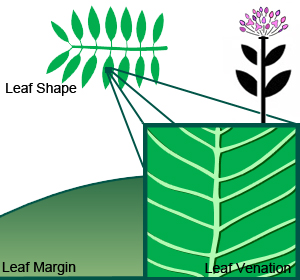 |
| Habitat | Roadsides, fields, and Waste Places | |
| Leaves | Compound leaves 5cm to 10cm long, divided into 15-25 leaflets each 15mm to 20mm long | |
| Leaf Margin | Entire | |
| Leaf Venation | Pinnately lobed | |
| Stems | Winding vine | |
| Flowering Season | June to August | |
| Flower Type | Rounded clusters of pink, sometimes whitish, flower clusters 2.5cm wide | |
| Flower Colour | pink with white | |
| Pollination | Insects and wind | |
| Flower Gender | Flowers are hermaphrodite and the plants are self-fertile | |
| Fruit | linear seed pod | |
| USDA Zone | 4A (-31.7°C to -34.4°C) cold weather limit |
![]()
The following health hazards should be noted when handling or choosing a location to plant crown vetch:
 |
ENVIRONMENTAL HAZARD Crown vetch is toxic to horses and other non-ruminants because of the presence of nitroglycosides. |
 |
TOXIC The whole plant contains a toxic glycoside called coronillin and is toxic if consumed. |
![]()
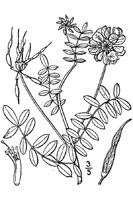 |
-Click here- or on the thumbnail image to see an artist rendering, from The United States Department of Agriculture, of crown vetch. (This image will open in a new browser tab) |
![]()
 |
-Click here- or on the thumbnail image to see a magnified view, from The United States Department of Agriculture, of the seeds created by crown vetch for propagation. (This image will open in a new browser tab) |
![]()
Crown Vetch can be translated into the following select languages:
| Arabic | تاج البيقية | Bulgarian | корона фий | Chinese (Sim) | 冠花 |
| Croatian | kruna grahorice | Czech | koruna hrachor | Danish | krone vikke |
| Dutch | kroon wikke | Esperanto | krono vetch | Estonian | kroon hiirehernes |
| Finnish | kruunu virna | French | coronille | German | Kronenwicke |
| Greek | στέμμα βίκος | Hebrew | קיה הכתר | Hungarian | korona bükköny |
| Italian | corona veccia | Japanese | クラウンベッチ | Korean | 크라운 연꽃 |
| Low Saxon | Lithuanian | karūna vikis | Norwegian | krone vetch | |
| Persian | ماش تاج | Polish | korony wyka | Portuguese | coroa ervilhaca |
| Romanian | coroana măzăriche | Russian | корона вика | Slovak | koruna hrachor |
| Spanish | corona veza | Swedish | krona vicker | Tagalog | korona halamang gisantes |
| Turkish | taç fiğ | Ukrainian | корона вика | Vietnamese | vương miện đậu tằm |

![]()
 |
The MIROFOSS database offers free printable garden tags for personal and non-profit use. These tags can be used to properly identify plant samples in a garden. Click on the tags shown on the the screen or -click here- to download a full size jpeg image for a crown vetch identification tag; which can be printed on paper or used with a plastic laser printer. |
 |
What's this? What can I do with it? |
![]()
| Description / Application | Department of Primary Industries. Victorian Government. Retrieved 2014-02-15 |
| Description | Burns JC, Cope WA. 1974. Nutritive Value of Crownvetch Forage as Influenced by Structural Constituents and Phenolic and Tannin Compounds. Agronomy Journal, 66, p 195-200. |
| Folklore | Survival and Self Sufficiency. Retrieved 2014-02-15 |
| Biology | Reynolds PJ, Jackson C, Lindahl IL, Henson PR. 1967. Consumption and Digestibility of Crownvetch (Coronilla varia L.) Forage by Sheep. Agronomy Journal, 59, p 589-591. |
| Biology | Moyer BG, Gustine DL. 1984. Regeneration of Coronilla varia L. (crownvetch) plants from callus culture. Journal of Plant Biotechnology, 3, 143-148. |
| Biology | Gustine, D. L., & Moyer, B. G. (1990). Crownvetch (Coronilla varia L.). In Legumes and Oilseed Crops I (pp. 341-354). Springer Berlin Heidelberg. |
| Biology | Dickinson, T.; Metsger, D.; Bull, J.; & Dickinson, R. (2004) ROM Field Guide to Wildflowers of Ontario. Toronto:Royal Ontario Museum, |
| Image Rendering | USDA-NRCS PLANTS Database / USDA NRCS. Wetland flora: Field office illustrated guide to plant species. USDA Natural Resources Conservation Service. |
| Environment | National Audubon Society. Field Guide To Wildflowers (Eastern Region): Alfred A. Knopf. ISBN 0-375-40232-2 |
| Physical Identification | National Audubon Society. Field Guide To Wildflowers (Eastern Region): Alfred A. Knopf. ISBN 0-375-40232-2 |
| February 18, 2015 | The last time this page was updated |
| ©2025 MIROFOSS™ Foundation | |
 |
|

